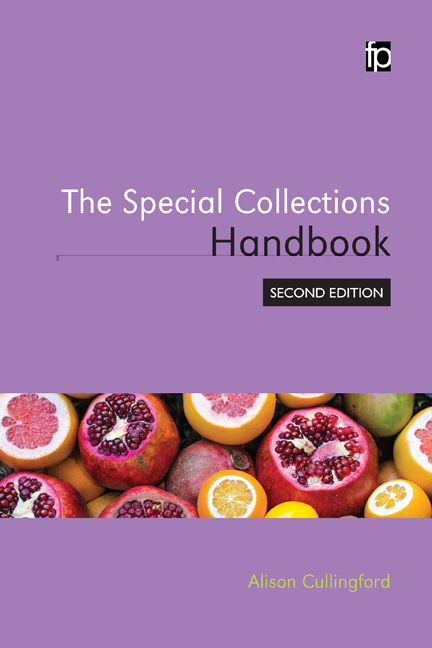Book contents
- Frontmatter
- Contents
- Preface and acknowledgements
- Introduction
- 1 The care of Special Collections
- 2 Emergency planning for Special Collections
- 3 Understanding objects in Special Collections
- 4 Acquiring and developing Special Collections
- 5 Cataloguing, description and metadata in Special Collections
- 6 Digitization and digital libraries in Special Collections
- 7 Legal and ethical issues in Special Collections
- 8 User services in Special Collections
- 9 Marketing and communications in Special Collections
- 10 Widening access to Special Collections
- 11 Organizational resources for Special Collections: space and people
- 12 Influencing and fund-raising for Special Collections
- Afterword: Special Collections futures
- Appendix A The Special Collections reference shelf
- Appendix B Skills for your Special Collections career
- Bibliography
- Index
5 - Cataloguing, description and metadata in Special Collections
- Frontmatter
- Contents
- Preface and acknowledgements
- Introduction
- 1 The care of Special Collections
- 2 Emergency planning for Special Collections
- 3 Understanding objects in Special Collections
- 4 Acquiring and developing Special Collections
- 5 Cataloguing, description and metadata in Special Collections
- 6 Digitization and digital libraries in Special Collections
- 7 Legal and ethical issues in Special Collections
- 8 User services in Special Collections
- 9 Marketing and communications in Special Collections
- 10 Widening access to Special Collections
- 11 Organizational resources for Special Collections: space and people
- 12 Influencing and fund-raising for Special Collections
- Afterword: Special Collections futures
- Appendix A The Special Collections reference shelf
- Appendix B Skills for your Special Collections career
- Bibliography
- Index
Summary
Introduction
In this chapter we discuss the essential first step in bringing Special Collections to users: cataloguing. Many Special Collections librarians have cataloguing responsibilities. All librarians working with such collections need to understand how the materials in their care have been catalogued, in order to help users and make effective decisions. This chapter will:
Introduce Special Collections metadata.
Outline the most important codes, standards and controlled vocabularies for Special Collections metadata.
Discuss key developments: linked data, Functional Requirements for Bibliographic Records/Resource Description and Access (FRBR/RDA) and the future of Machine Readable Cataloguing (MARC).
Examine the massive problem of ‘hidden collections’.
Discuss classification and shelf arrangements of Special Collections.
Discuss marking and labelling of Special Collections materials.
A note on terminology and some key concepts
Metadata can be simply defined as ‘data about data’. All metadata creation is based around the use of standards and codes, which produces searchable and predictable results and allows metadata to be shared and reused. Crosswalks map similar elements in different metadata standards onto each other. The match is unlikely to be perfect because different standards record and code information in different ways, but they enable resources to be created from many sources using different metadata standards. Library catalogues and archival descriptions are metadata, though the term is most commonly encountered when dealing with digital materials. In libraries, cataloguing is used for the process of metadata creation and catalogue and catalogue record for what is produced. Archives also refer to archival description, and their end products are known as descriptions or finding aids. Note that the term processing is often used, especially in the USA, to cover cataloguing of all kinds, plus the other activities required to make materials accessible.
Book cataloguing: some history, introducing AACR and MARC
Librarians have been developing cataloguing codes since the publication in 1841 of Panizzi's Rules for the British Museum Library (find out more about cataloguing history via the ‘Useful websites’).
The Anglo-American Cataloguing Rules, first published in 1967 and revised several times since, are the most significant historic library cataloguing standard for new librarians to consider. The 2nd edition, known as AACR2 (Gorman and Winkler, 1978), would have been used in most Special Collections’ parent libraries and, as we will see, is the basis for many other standards.
- Type
- Chapter
- Information
- The Special Collections Handbook , pp. 91 - 112Publisher: FacetPrint publication year: 2016



